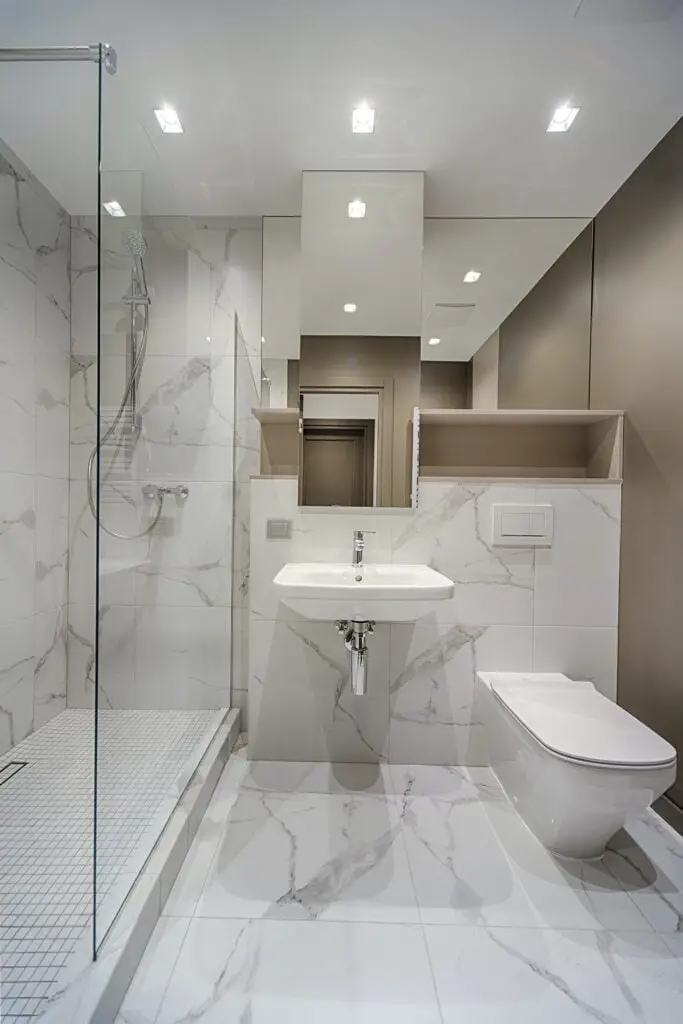It takes a lot of preparation work to install a new floor, including ripping out the outdated tiles. Although you could just cover the old tiles with the new ones, removing the tiles has many benefits.
These include examining the condition of your subfloor and looking for mold problems. You can determine whether there are any issues that need to be fixed before covering the tile again if you totally remove it before beginning any new flooring project. Instead of letting the issue worsen, you can take care of any necessary repairs or mold removal.
Can I Remove Tile Myself?
Tile removal is a lot of labor, but you can save thousands of dollars by doing it yourself instead of paying a professional. To prevent harming your subfloor, it’s crucial to have everything you need and to complete the task correctly (or the tiles, if you want to repurpose them). The best course of action is self-removal if you feel up to a DIY project.
How Much Does it Cost to Hire a Professional?
It can add thousands of dollars to the price of a floor installation to hire a professional to do it for you. The price is based on the room’s size. The costs of hauling away the tile are in addition to the labor charges for removing it. Average tile removal costs range from $2 to $5 per square foot.

Equipment for Tile Removal
Prior to beginning any tile removal process, it’s crucial to confirm that you have all necessary equipment. Along with the tools needed to remove the tiles themselves, this also contains safety equipment to safeguard you and others.
Safety Gear
It’s crucial to follow all safety precautions when removing tile because it can be a dangerous task. This calls for purchasing safety goggles to shield your eyes, a dust mask to prevent dust inhalation, and leather gloves to shield your hands. Anyone entering the work area should be wearing safety equipment.
Tools
Paint scraper, floor scraper, chisel, and a drop sheet to catch the dust are the instruments you’ll need to remove the tile. You can start over by entirely clearing the floor of all materials and scraping the tile. You might need a hammer to break up the tile, depending on how it was initially installed. You’ll need a screw gun, a roofing rake, and a flat shovel to remove the underlayment.
Tile Removal Steps
Step 1: Removing the Trim
The first step in removing the tile is to take out all of the room’s baseboards and trim. When removing the tile and installing your new floor, be careful not to damage any of the materials you remove. This will make it easier to reinstall them. Cover any vents in the room as well to prevent dust from entering them (and from there the rest of your house).
Step 2: Removing the Tile
It’s time to really remove the tile once all trimmings have been moved out of the way. If you wish to retain the tiles rather than just replace them, this approach is more difficult. You can begin by breaking the tiles with a hammer if you don’t care about preserving them. Start by using the edge of a hammer to smash one tile at a time. The remainder of that tile should be removed, followed by the tiles close by, using a chisel. At least one tile will need to be broken, but the remaining tiles can be saved if you carefully pry up the tiles close to the broken one. They should be simple to remove using the claw end of the hammer.
If breaking them all up with a hammer is easier for you than prying them up and you don’t care about protecting the tile, do so. It might not be possible to preserve your tile if it is glued to the floor with cement. If the tiles are difficult to remove, smash them up with a hammer and remove them with a floor scraper.
Step 3: Removing the Underlayment
Check the condition of the underlayment once all of the tiles have been totally removed. The underlayment can be removed by using a hammer, however it could need to be replaced based on how well it is maintained. It might be worth your time and money to take out the underlayment and replace it because adhesive removal might be difficult. If it’s ancient, it might already be degrading. Before removing the underlayment from the floor, take out any screws that could be holding it in place. The margins of the underlayment should then be raised using a flat shovel or a roofing rake.
Step 4: Cleaning the Subfloor
After the underlayment has been taken out, the subfloor needs to be cleaned. Clean up any screws, tile fragments, or other debris that is on the subfloor after scraping off any leftover glue. Look for any mold or damage that may need to be repaired. Make any repairs or cleanings that are required. The subfloor needs to be spotless, clean, and in good condition prior to putting in a new floor. Covering up damage or mold that could possibly worsen over time is not a good idea.
How Can I Make Sure My Floor Doesn’t Have Asbestos?
Asbest was used to lay some ancient tile flooring, which is toxic since it can enter your lungs and cause infections. Having a professional examine the area for asbestos fibers is the only reliable way to establish whether or not your floor has asbestos. You can examine the size of the tiles that were on the floor, though (and for an outline of older tiles underneath). Asbestos was frequently utilized with tiles that size, thus if the tiles measure nine inches on each side, there may be asbestos present.
How Can I Dispose of the Old Tile?
If you hired a professional to remove your tile, the installer would charge a fee and then take care of everything. You’ll have to dispose of the tile yourself if you remove it yourself. Old tiles are typically not recyclable using standard recycling methods. You can take it to your neighborhood recycling center after confirming with them by phone that they would accept it. You might give your tiles to someone else who might need them if they’re in good condition. Some neighborhood construction projects could be appreciative of an offer of free tile.
What Might Require a Professional?
If asbestos is found, a professional must clean up and remove it. You must hire experts to handle asbestos because it might be risky to handle on your own. Before laying new tile on top of a broken or moldy subfloor, you might want to think about hiring a professional to fix it so that you can be sure it is stable and thoroughly clean.
To see other material construction prices, please see here.
To know other construction guides, tips, and methodology for beginners, veterans, and contractors, please see here.
To know the flood prone areas in the Philippines, Top 10 Flood-Prone Areas to Live in the Philippines.
To know more about Concrete Hollow Blocks, Simple Reasons Why Hollow Blocks are Highly Used in the Philippines

